Impact and Effectiveness of COVID-19 Vaccines Based on Machine Learning Analysis of a Time Series: A Population-Based Study
Abstract
:1. Introduction
Hypothesis and Objectives of Our Research
2. Materials and Methods
2.1. Data Collection and Study Design
2.2. Inclusion and Exclusion Criteria
2.3. Definition of Waves
2.4. Vaccination Rollout
2.5. Estimated Scenarios of the Unvaccinated Population
2.6. Mathematical Modeling of Hospitalizations and Mortality
2.7. Machine Learning Algorithms
2.8. Fitting the Models
2.9. Statistical Analyses
3. Results
3.1. Nationwide Overview of the Pandemic
3.2. Vaccination Rollout
3.3. Hospitalizations and Deaths in an Estimated Scenario
4. Discussion
4.1. Descriptive Analyses
4.2. Vaccination Rollout
4.3. Modeling and Estimating Data in a Non-Vaccination Scenario
4.4. Limitations
5. Conclusions
Author Contributions
Funding
Institutional Review Board Statement
Informed Consent Statement
Data Availability Statement
Conflicts of Interest
Abbreviations
| ARIMA | Auto-Regressive Integrated Moving Average |
| COVID-2019 | Coronavirus Disease 2019 |
| EN | ElasticNet |
| EU/EEA | European Union/European Economic Area |
| LSTM | Long Short-Term Memory |
| MBDS-H | Minimum Basic Data Set at Hospitalization |
| SARS-CoV-2 | Severe Acute Respiratory Syndrome Coronavirus 2 |
| MCMC | Markov Chain with Monte Carlo |
| RF | Random Forest |
Appendix A. Descriptive Analyses
Appendix A.1. Estimated Scenarios of the Unvaccinated Population
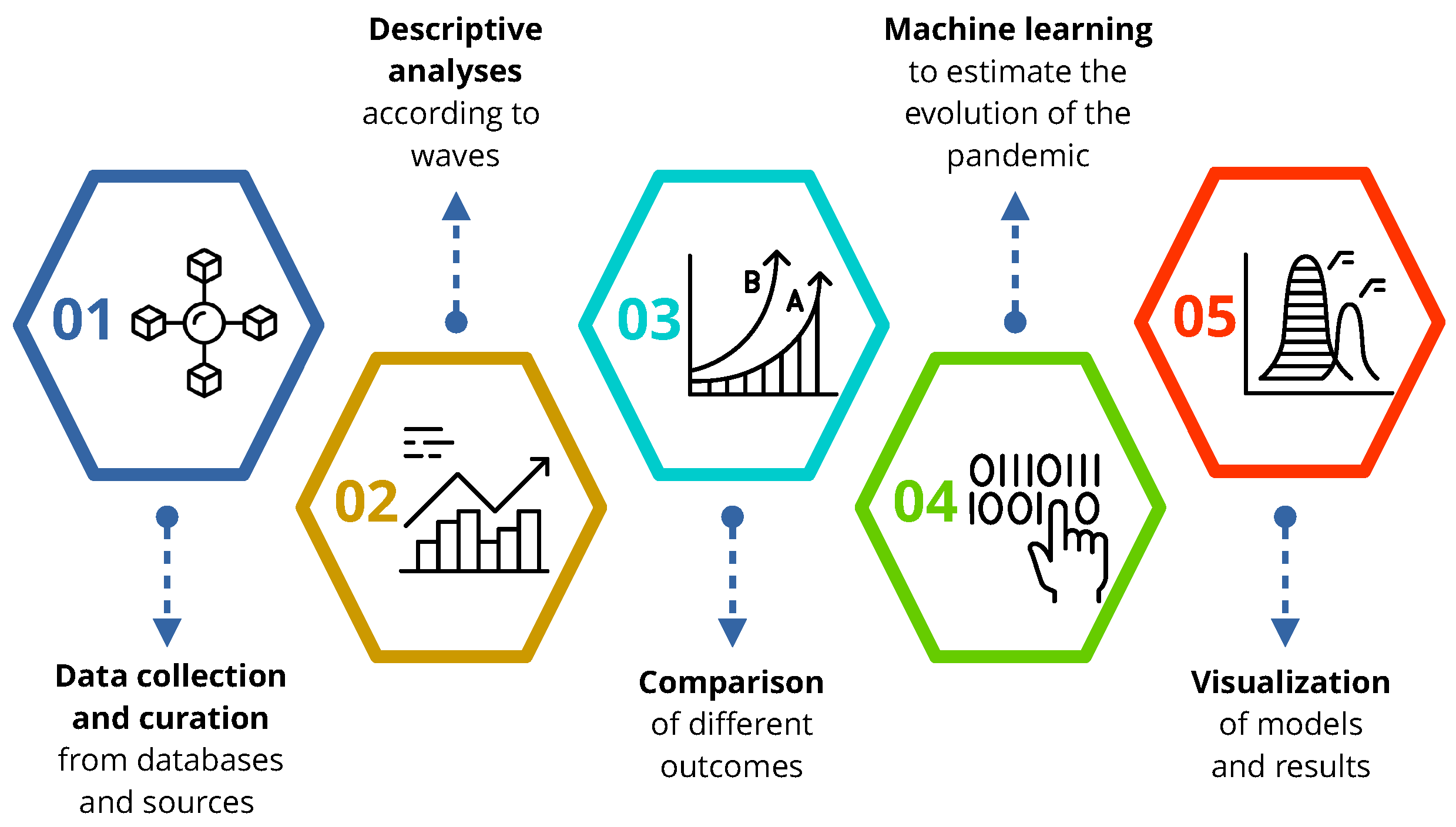
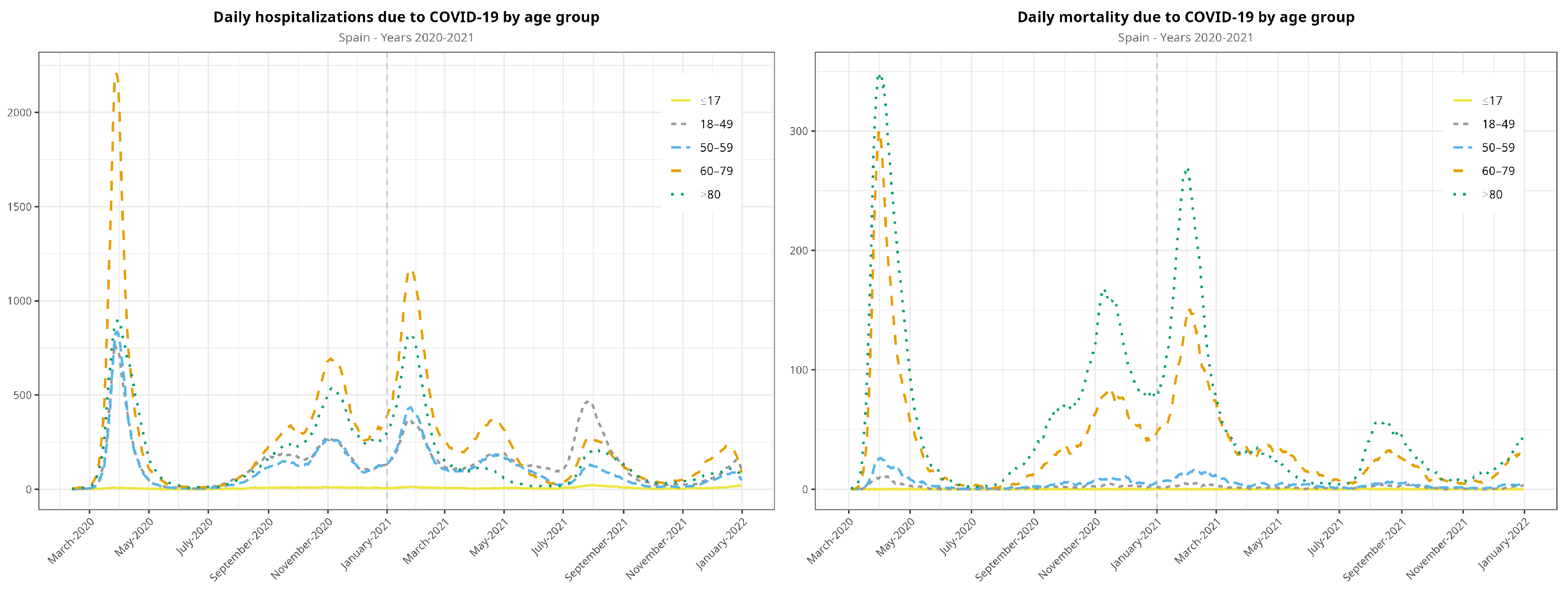
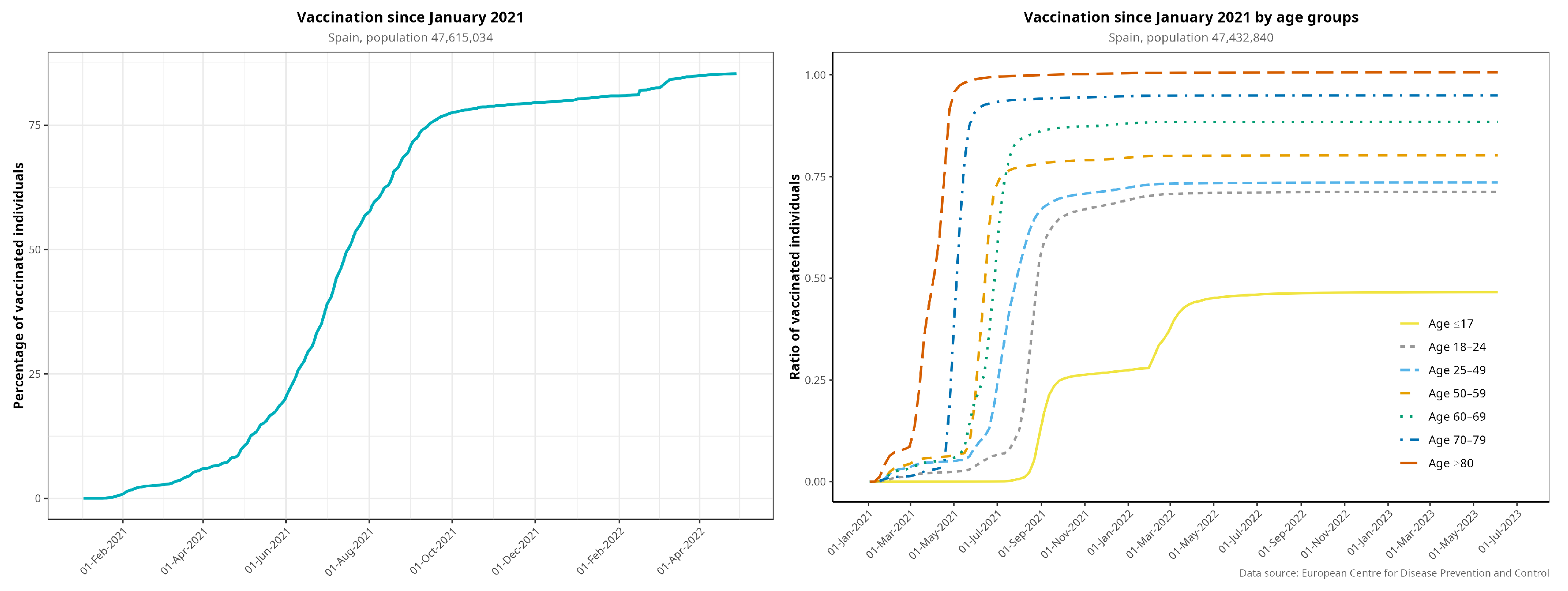
Appendix A.2. Mathematical Modeling of Hospitalizations and Mortality

Appendix A.3. Machine Learning Algorithms
References
- Hosseinzadeh, P.; Zareipour, M.; Baljani, E.; Moradali, M. Social Consequences of the COVID-19 Pandemic. A Systematic Review. Investig. Educ. Enferm. 2022, 40, e10. [Google Scholar] [CrossRef] [PubMed]
- Mofijur, M.; Rizwanul Fattah, I.M.; Alam, M.A.; Islam, A.B.M.S.; Ong, H.C.; Rahman, S.M.A.; Najafi, G.; Ahmed, S.F.; Uddin, M.A.; Mahlia, T.M.I. Impact of COVID-19 on the social, economic, environmental and energy domains: Lessons learnt from a global pandemic. Sustain. Prod. Consum. 2021, 26, 343–359. [Google Scholar] [CrossRef] [PubMed]
- Osofsky, J.; Osofsky, H.; Mamon, L. Psychological and social impact of COVID-19. Psychol. Trauma Theory Res. Pract. Policy 2020, 12, 468–469. [Google Scholar] [CrossRef] [PubMed]
- Saladino, V.; Algeri, D.; Auriemma, V. The Psychological and Social Impact of COVID-19: New Perspectives of Well-Being. Front. Psychol. 2020, 11, 577684. [Google Scholar] [CrossRef] [PubMed]
- Patel, B.; Murphy, R.E.; Karanth, S.; Shiffaraw, S.; Peters, R.M., Jr.; Hohmann, S.F.; Greenberg, R.S. Surge in Incidence and Coronavirus Disease 2019 Hospital Risk of Death, United States, September 2020 to March 2021. Open Forum Infect Dis 2022, 9, ofac424. [Google Scholar] [CrossRef]
- Delahoy, M.; Ujamaa, D.; Whitaker, M.; O’Halloran, A.; Anglin, O.; Burns, E.; Cummings, C.; Holstein, R.; Kambhampati, A.K.; Milucky, J.; et al. Hospitalizations Associated with COVID-19 Among Children and Adolescents—COVID-NET, 14 States, March 1, 2020–August 14, 2021. MMWR Morb. Mortal. Wkly. Rep. 2021, 70, 1255–1260. [Google Scholar] [CrossRef]
- Taylor, C. COVID-19–Associated Hospitalizations Among Adults During SARS-CoV-2 Delta and Omicron Variant Predominance, by Race/Ethnicity and Vaccination Status—COVID-NET, 14 States, July 2021–January 2022. MMWR Morb. Mortal. Wkly. Rep. 2022, 71, 466–473. [Google Scholar] [CrossRef]
- Havers, F.P.; Pham, H.; Taylor, C.A.; Whitaker, M.; Patel, K.; Anglin, O.; Kambhampati, A.K.; Milucky, J.; Zell, E.; Moline, H.L.; et al. COVID-19-Associated Hospitalizations Among Vaccinated and Unvaccinated Adults 18 Years or Older in 13 US States, January 2021 to April 2022. JAMA Intern. Med. 2022, 182, 1071–1081. [Google Scholar] [CrossRef]
- de Sanidad, M. Situación actual Coronavirus. Available online: https://www.sanidad.gob.es/profesionales/saludPublica/ccayes/alertasActual/nCov/situacionActual.htm (accessed on 24 January 2024).
- Stefanelli, P.; Trentini, F.; Petrone, D.; Mammone, A.; Ambrosio, L.; Manica, M.; Guzzetta, G.; d’Andrea, V.; Marziano, V.; Zardini, A.; et al. Tracking the progressive spread of the SARS-CoV-2 Omicron variant in Italy, December 2021 to January 2022. Euro Surveill. 2022, 27, 2200125. [Google Scholar] [CrossRef]
- Assessment of the Further Spread and Potential Impact of the SARS-CoV-2 Omicron Variant of Concern in the EU/EEA, 19th Update. 2022. Available online: https://www.ecdc.europa.eu/en/publications-data/covid-19-omicron-risk-assessment-further-emergence-and-potential-impact (accessed on 15 October 2023).
- Markov, P.; Ghafari, M.; Beer, M.; Lythgoe, K.; Simmonds, P.; Stilianakis, N.; Katzourakis, A. The evolution of SARS-CoV-2. Nat. Rev. Microbiol. 2023, 21, 361–379. [Google Scholar] [CrossRef]
- Soheili, M.; Khateri, S.; Moradpour, F.; Mohammadzedeh, P.; Zareie, M.; Mortazavi, S.M.M.; Manifar, S.; Kohan, H.G.; Moradi, Y. The efficacy and effectiveness of COVID-19 vaccines around the world: A mini-review and meta-analysis. Ann. Clin. Microbiol. Antimicrob. 2023, 22, 42. [Google Scholar] [CrossRef] [PubMed]
- Harder, T.; Koch, J.; Vygen-Bonnet, S.; Külper-Schiek, W.; Pilic, A.; Reda, S.; Scholz, S.; Wichmann, O. Efficacy and effectiveness of COVID-19 vaccines against SARS-CoV-2 infection: Interim results of a living systematic review, 1 January to 14 May 2021. Eurosurveillance 2021, 26, 2100563. [Google Scholar] [CrossRef] [PubMed]
- Graña, C.; Ghosn, L.; Evrenoglou, T.; Jarde, A.; Minozzi, S.; Bergman, H.; Buckley, B.S.; Probyn, K.; Villanueva, G.; Henschke, N.; et al. Efficacy and safety of COVID-19 vaccines. Cochrane Database Syst. Rev. 2022, 12, CD015477. [Google Scholar] [PubMed]
- Yang, Z.R.; Jiang, Y.W.; Li, F.X.; Liu, D.; Lin, T.F.; Zhao, Z.Y.; Wei, C.; Jin, Q.Y.; Li, X.M.; Jia, Y.X.; et al. Efficacy of SARS-CoV-2 vaccines and the dose–response relationship with three major antibodies: A systematic review and meta-analysis of randomised controlled trials. Lancet Microbe 2023, 4, e236–e246. [Google Scholar] [CrossRef] [PubMed]
- Watson, O.; Barnsley, G.; Toor, J.; Hogan, A.; Winskill, P.; Ghani, A. Global impact of the first year of COVID-19 vaccination: A mathematical modelling study. Lancet Infect. Dis. 2022, 22, 1293–1302. [Google Scholar] [CrossRef]
- Zeng, B.; Gao, L.; Zhou, Q.; Yu, K.; Sun, F. Effectiveness of COVID-19 vaccines against SARS-CoV-2 variants of concern: A systematic review and meta-analysis. BMC Med. 2022, 20, 200. [Google Scholar] [CrossRef]
- Ministerio de Sanidad, Consumo y Bienestar Social. Portal Estadistico. Area de Inteligencia de Gestion. Available online: https://pestadistico.inteligenciadegestion.mscbs.es/publicoSNS/comun/ArbolNodos.aspx?idNodo=23525 (accessed on 6 July 2019).
- Data on COVID-19 vaccination in the EU/EEA. 2023. Available online: https://www.ecdc.europa.eu/en/publications-data/data-covid-19-vaccination-eu-eea (accessed on 15 October 2023).
- Garcia-Carretero, R.; Vazquez-Gomez, O.; Gil-Prieto, R.; Gil-de Miguel, A. Hospitalization burden and epidemiology of the COVID-19 pandemic in Spain (2020–2021). BMC Infect. Dis. 2023, 23, 476. [Google Scholar] [CrossRef]
- Instituto de Salud Carlos III. Informe no 128 Situación de COVID-19 en España a 10 de mayo de 2022.pdf. 2022. Available online: https://www.isciii.es/QueHacemos/Servicios/VigilanciaSaludPublicaRENAVE/EnfermedadesTransmisibles/Documents/INFORMES/Informes%20COVID-19/INFORMES%20COVID-19%202022/Informe%20n%C2%BA%20128%20Situaci%C3%B3n%20de%20COVID-19%20en%20Espa%C3%B1a%20a%2010%20de%20mayo%20de%202022.pdf (accessed on 9 June 2022).
- Gobierno de España. Estrategia de vacunación COVID-19. Available online: https://www.vacunacovid.gob.es/ (accessed on 12 September 2024).
- Rodriguez-Maroto, G.; Atienza-Diez, I.; Ares, S.; Manrubia, S. Vaccination strategies in structured populations under partial immunity and reinfection. J. Phys. A Math. Theor. 2023, 56, 204003. [Google Scholar] [CrossRef]
- Garcia-Carretero, R.; Vigil-Medina, L.; Barquero-Perez, O.; Ramos-Lopez, J. Relevant Features in Nonalcoholic Steatohepatitis Determined Using Machine Learning for Feature Selection. Metab. Syndr. Relat. Disord. 2019, 17, 444–451. [Google Scholar] [CrossRef]
- Garcia-Carretero, R.; Barquero-Perez, O.; Mora-Jimenez, I.; Soguero-Ruiz, C.; Goya-Esteban, R.; Ramos-Lopez, J. Identification of clinically relevant features in hypertensive patients using penalized regression: A case study of cardiovascular events. Med. Biol. Eng. Comput. 2019, 57, 2011–2026. [Google Scholar] [CrossRef]
- Garcia-Carretero, R.; Vigil-Medina, L.; Barquero-Perez, O.; Mora-Jimenez, I.; Soguero-Ruiz, C.; Goya-Esteban, R.; Ramos-Lopez, J. Logistic LASSO and Elastic Net to Characterize Vitamin D Deficiency in a Hypertensive Obese Population. Metab. Syndr. Relat. Disord. 2020, 18, 79–85. [Google Scholar] [CrossRef] [PubMed]
- R Core Team. R: A Language and Environment for Statistical Computing; R Foundation for Statistical Computing: Vienna, Austria, 2020; Available online: https://www.r-project.org/ (accessed on 12 September 2024).
- Farsalinos, K.; Poulas, K.; Vantarakis, A.; Leotsinidis, M.; Kouvelas, D.; Docea, A.O.; Kostoff, R.; Gerotziafas, G.T.; Antoniou, M.N.; Polosa, R.; et al. Improved strategies to counter the COVID-19 pandemic: Lockdowns vs. primary and community healthcare. Toxicol. Rep. 2021, 8, 1–9. [Google Scholar] [CrossRef] [PubMed]
- Connors, M.; Graham, B.; Lane, H.; Fauci, A. SARS-CoV-2 Vaccines: Much Accomplished, Much to Learn. Ann. Intern. Med. 2021, 174, 687–690. [Google Scholar] [CrossRef]
- Kustin, T.; Harel, N.; Finkel, U.; Perchik, S.; Harari, S.; Tahor, M.; Caspi, I.; Levy, R.; Leshchinsky, M.; Ken Dror, S.; et al. Evidence for increased breakthrough rates of SARS-CoV-2 variants of concern in BNT162b2-mRNA-vaccinated individuals. Nat. Med. 2021, 27, 1379–1384. [Google Scholar] [CrossRef] [PubMed]
- Wang, Z.; Muecksch, F.; Schaefer-Babajew, D.; Finkin, S.; Viant, C.; Gaebler, C.; Hoffmann, H.H.; Barnes, C.O.; Cipolla, M.; Ramos, V.; et al. Naturally enhanced neutralizing breadth against SARS-CoV-2 one year after infection. Nature 2021, 595, 426–431. [Google Scholar] [CrossRef]
- Garcia-Carretero, R.; Vazquez-Gomez, O.; Ordoñez-Garcia, M.; Garrido-Peño, N.; Gil-Prieto, R.; Gil-de Miguel, A. Differences in Trends in Admissions and Outcomes among Patients from a Secondary Hospital in Madrid during the COVID-19 Pandemic: A Hospital-Based Epidemiological Analysis (2020–2022). Viruses 2023, 15, 1616. [Google Scholar] [CrossRef]
- Barandalla, I.; Alvarez, C.; Barreiro, P.; de Mendoza, C.; González-Crespo, R.; Soriano, V. Impact of scaling up SARS-CoV-2 vaccination on COVID-19 hospitalizations in Spain. Int. J. Infect. Dis. 2021, 112, 81–88. [Google Scholar] [CrossRef]
- Sentís, A.; Kislaya, I.; Nicolay, N.; Meijerink, H.; Starrfelt, J.; Martínez-Baz, I.; Castilla, J.; Nielsen, K.F.; Hansen, C.H.; Emborg, H.-D.; et al. Estimation of COVID-19 vaccine effectiveness against hospitalisation in individuals aged ≥65 years using electronic health registries; a pilot study in four EU/EEA countries, October 2021 to March 2022. Eurosurveillance 2022, 27, 2200551. [Google Scholar] [CrossRef]
- Chyon, F.; Suman, M.; Fahim, M.; Ahmmed, M. Time series analysis and predicting COVID-19 affected patients by ARIMA model using machine learning. J. Virol. Methods 2022, 301, 114433. [Google Scholar] [CrossRef]
- Maleki, M.; Mahmoudi, M.; Wraith, D.; Pho, K. Time series modelling to forecast the confirmed and recovered cases of COVID-19. Travel Med. Infect. Dis. 2020, 37, 101742. [Google Scholar] [CrossRef]
- Kırbaş, İ.; Sözen, A.; Tuncer, A.; Kazancıoğlu, F. Comparative analysis and forecasting of COVID-19 cases in various European countries with ARIMA, NARNN and LSTM approaches. Chaos Solitons Fractals 2020, 138, 110015. [Google Scholar] [CrossRef] [PubMed]
- Nabi, K.; Tahmid, M.; Rafi, A.; Kader, M.; Haider, M. Forecasting COVID-19 cases: A comparative analysis between recurrent and convolutional neural networks. Results Phys. 2021, 24, 104137. [Google Scholar] [CrossRef] [PubMed]
- Makridakis, S.; Spiliotis, E.; Assimakopoulos, V.; Semenoglou, A.; Mulder, G.; Nikolopoulos, K. Statistical, machine learning and deep learning forecasting methods: Comparisons and ways forward. J. Oper. Res. Soc. 2023, 74, 840–859. [Google Scholar] [CrossRef]
- Whittaker, C.; Walker, P.G.; Alhaffar, M.; Hamlet, A.; Djaafara, B.A.; Ghani, A.; Ferguson, N.; Dahab, M.; Checchi, F.; Watson, O.J. Under-reporting of deaths limits our understanding of true burden of COVID-19. BMJ 2021, 375, n2239. [Google Scholar] [CrossRef] [PubMed]
- Tibshirani, R. Regression Shrinkage and Selection via the Lasso. JOurnal R. Stat. Soc. Ser. B (Methodol.) 1996, 58, 267–288. [Google Scholar] [CrossRef]
- Breiman, L. Random Forests. Mach. Learn. 2001, 45, 5–32. [Google Scholar] [CrossRef]
- Cutler, D.; Edwards, T., Jr.; Beard, K.; Cutler, A.; Hess, K.; Gibson, J.; Lawler, J.J. Random forests for classification in ecology. Ecology 2007, 88, 2783–2792. [Google Scholar] [CrossRef]
- Garcia-Carretero, R.; Vazquez-Gomez, O.; Lopez-Lomba, M.; Gil-Prieto, R.; Gil-de Miguel, A. Insulin Resistance and Metabolic Syndrome as Risk Factors for Hospitalization in Patients with COVID-19: Pilot Study on the Use of Machine Learning. Metab. Syndr. Relat. Disord. 2023, 21, 443–452. [Google Scholar] [CrossRef]
- Garcia-Carretero, R.; Vigil-Medina, L.; Mora-Jimenez, I.; Soguero-Ruiz, C.; Barquero-Perez, O.; Ramos-Lopez, J. Use of a K-nearest neighbors model to predict the development of type 2 diabetes within 2 years in an obese, hypertensive population. Med. Biol. Eng. Comput. 2020, 58, 991–1002. [Google Scholar] [CrossRef]
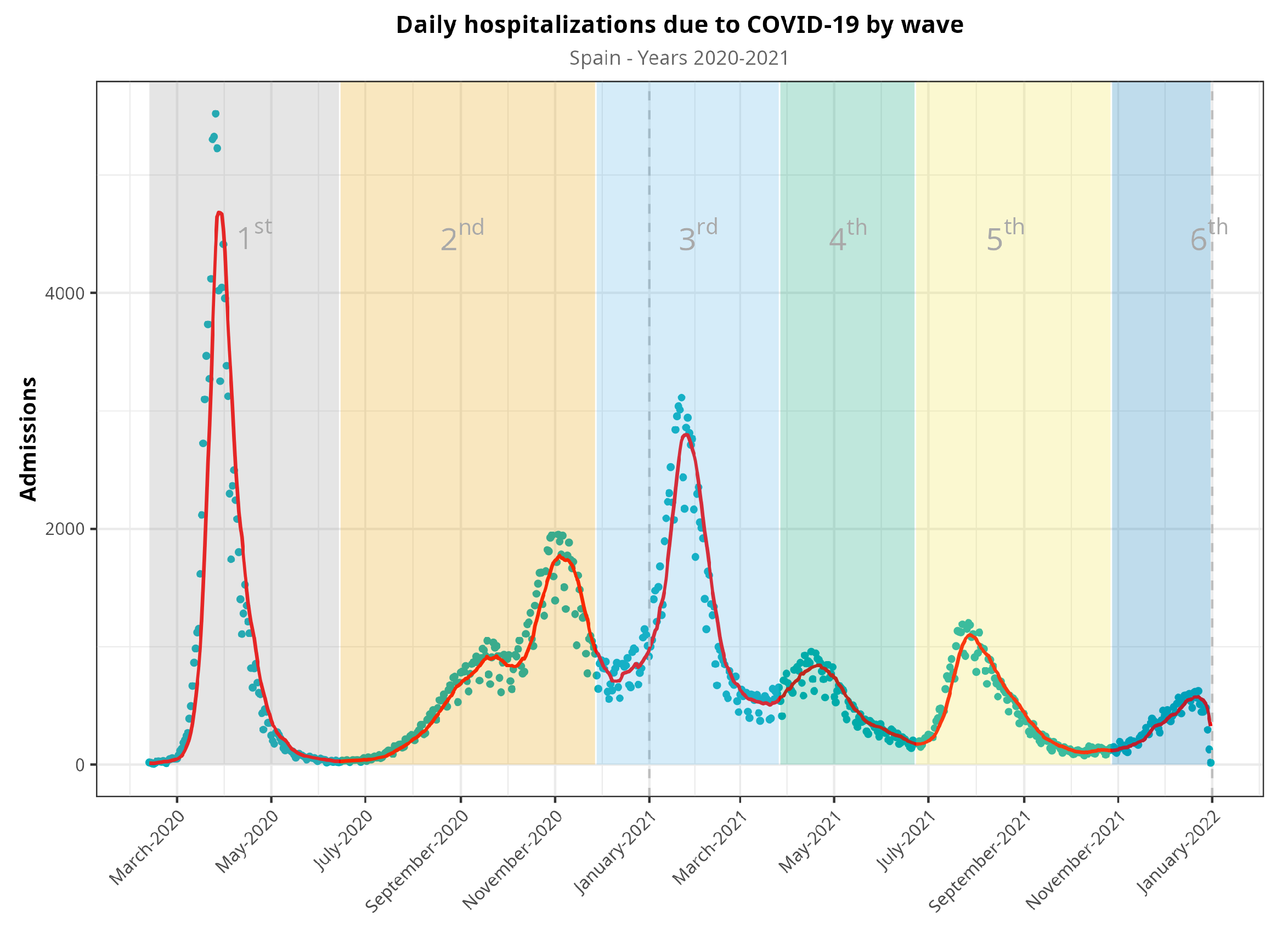



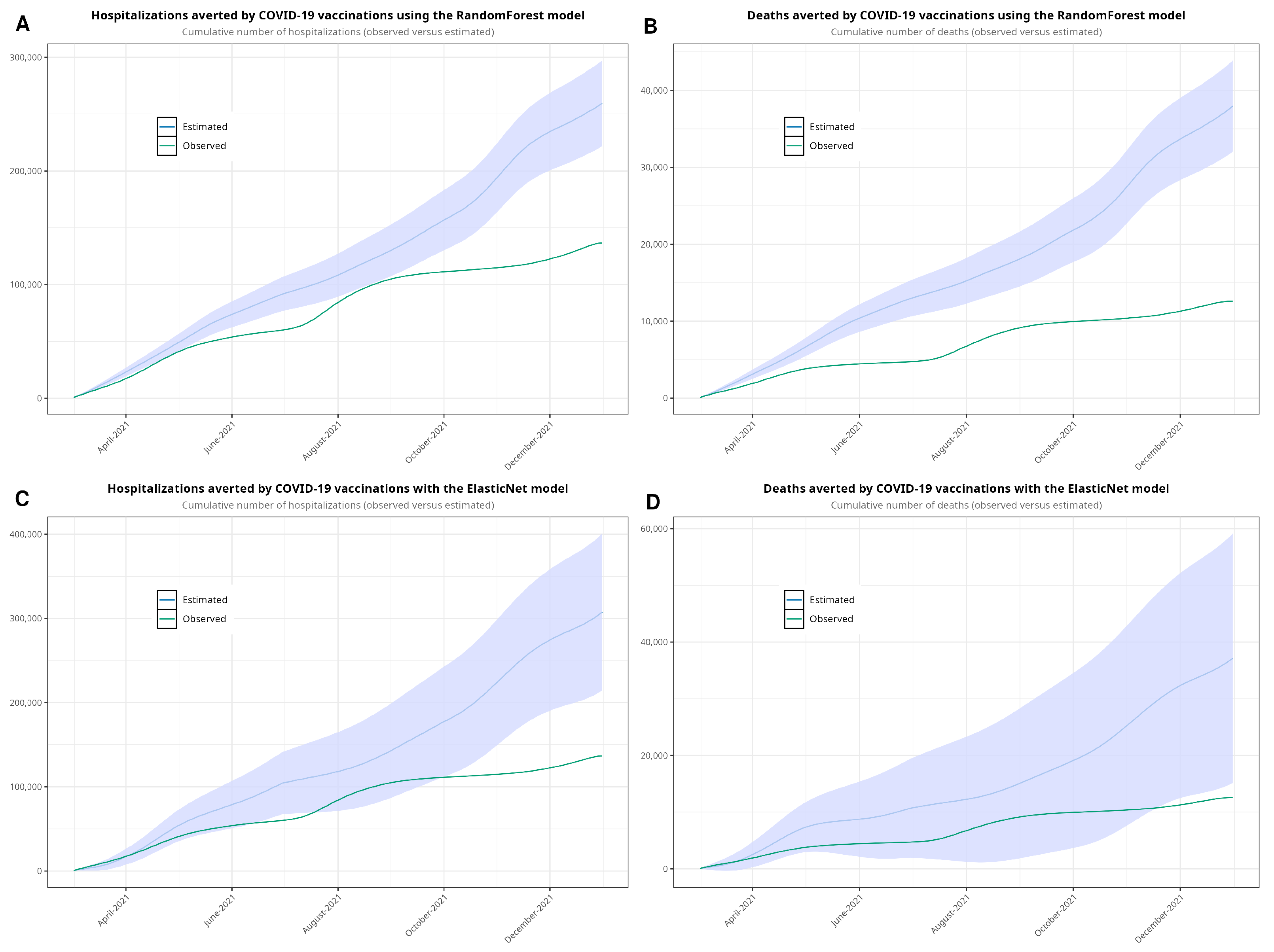
| All Waves | First | Second | Third | Fourth | Fifth | Sixth | p Value | |
|---|---|---|---|---|---|---|---|---|
| Hospital admissions | 498,789 | 115,356 | 127,114 | 126,623 | 51,006 | 54,570 | 24,120 | 0.001 |
| Sex (men) | 56.1% | 56.2% | 55.5% | 56.2% | 57.5% | 55.3% | 56.2% | 0.001 |
| Age, median (IQR) | 66 (28) | 69 (25) | 68 (28) | 69 (25) | 59 (24) | 57 (38) | 65 (28) | 0.001 |
| Hospital stay, median (IQR) | 8 (9) | 11.9 (9) | 8 (9) | 12.1 (9) | 7 (7) | 10.4 (8) | 6 (7) | 0.001 |
| ICU | ||||||||
| Admissions | 54,354 | 10,218 | 13,302 | 14,441 | 7194 | 6941 | 2258 | 0.001 |
| ICU (%) | 10.9 | 8.9 | 10.5 | 11.4 | 14.1 | 12.7 | 9.4 | 0.001 |
| ICU stay, median (IQR) | 10 (21) | 11 (22.3) | 10 (21.4) | 11 (21.5) | 11 (21.4) | 10 (18.7) | 6 (9.1) | 0.001 |
| Mortality | ||||||||
| Deaths | 71,437 | 21,037 | 18,229 | 20,400 | 3793 | 5487 | 2491 | 0.001 |
| Mortality rate (%) | 14.3 | 18.2 | 14.3 | 16.1 | 7.4 | 10.1 | 10.3 | 0.001 |
| Comorbidities | ||||||||
| Type 2 diabetes | 21.7 | 20.6 | 23.2 | 24.3 | 18.3 | 18.3 | 21.4 | 0.001 |
| Hypertension | 33.8 | 35.2 | 34.7 | 37.2 | 31.1 | 25.0 | 31.6 | 0.001 |
| AMI | 7.1 | 7.3 | 7.4 | 7.9 | 5.3 | 5.7 | 7.5 | 0.001 |
| CHF | 7.2 | 6.5 | 7.8 | 8.4 | 4.2 | 6.8 | 7.9 | 0.001 |
| Dementia | 4.8 | 5.5 | 5.4 | 5.2 | 2.1 | 3.9 | 3.6 | 0.001 |
| Kidney disease | 10.5 | 10.3 | 11.2 | 11.7 | 6.5 | 9.7 | 11.1 | 0.001 |
| Liver disease | 0.4 | 0.4 | 0.4 | 0.5 | 0.3 | 0.4 | 0.5 | 0.001 |
| Malignancy | 5.6 | 5.4 | 5.8 | 6.0 | 4.2 | 5.3 | 7.4 | 0.001 |
| Obesity | 12.9 | 9.2 | 12.6 | 14.0 | 17.0 | 14.4 | 13.8 | 0.001 |
| COPD | 7.4 | 7.6 | 7.4 | 7.9 | 5.9 | 6.6 | 8.8 | 0.001 |
| CEVD | 0.7 | 0.7 | 0.8 | 0.9 | 0.5 | 0.6 | 0.8 | 0.001 |
| Total | First Wave | Second Wave | Third Wave | Fourth Wave | Fifth Wave | Sixth Wave | p-Value | |||||||
|---|---|---|---|---|---|---|---|---|---|---|---|---|---|---|
| Admissions | ||||||||||||||
| ≤17 | 6568 | 583 | (8.9%) | 1622 | (24.7%) | 1021 | (15.5%) | 657 | (10%) | 1764 | (26.9%) | 921 | (14%) | 0.001 |
| 18–49 | 99,570 | 18,223 | (18.3%) | 23,525 | (23.6%) | 18,542 | (18.6%) | 13,669 | (13.7%) | 20,660 | (20.7%) | 4951 | (5%) | 0.001 |
| 50–59 | 78,535 | 18,524 | (23.6%) | 19,534 | (24.9%) | 19,432 | (24.7%) | 11,560 | (14.7%) | 6262 | (8%) | 3223 | (4.1%) | 0.001 |
| 60–79 | 178,667 | 45,100 | (25.2%) | 44,052 | (24.7%) | 48,808 | (27.3%) | 18,198 | (10.2%) | 13,267 | (7.4%) | 9242 | (5.2%) | 0.001 |
| ≥80 | 125,834 | 30,642 | (24.4%) | 35,998 | (28.6%) | 36,365 | (28.9%) | 5806 | (4.6%) | 11,707 | (9.3%) | 5316 | (4.2%) | 0.001 |
| ICU | ||||||||||||||
| ≤17 | 490 | 95 | (19.4%) | 109 | (22.2%) | 74 | (15.1%) | 62 | (12.7%) | 111 | (22.7%) | 39 | (8%) | 0.001 |
| 18–49 | 10,227 | 1493 | (14.6%) | 2186 | (21.4%) | 1,957 | (19.1%) | 1513 | (14.8%) | 2633 | (25.7%) | 445 | (4,4%) | 0.001 |
| 50–59 | 11,187 | 2117 | (18.9%) | 2733 | (24.4%) | 2994 | (26.8%) | 1705 | (15.2%) | 1240 | (11.1%) | 398 | (3.6%) | 0.001 |
| 60–79 | 28,548 | 5862 | (20.5%) | 7159 | (25.1%) | 8300 | (29.1%) | 3537 | (12.4%) | 2526 | (8.8%) | 1164 | (4.1%) | 0.001 |
| ≥80 | 2372 | 342 | (14.4%) | 754 | (31.8%) | 687 | (29%) | 185 | (7.8%) | 248 | (10.5%) | 156 | (6.6%) | 0.001 |
| Deaths | ||||||||||||||
| ≤l7 | 27 | 4 | (14.8%) | 7 | (25.9%) | 6 | (22.2%) | 2 | (7.4%) | 6 | (22.2%) | 2 | (7.4%) | 0.001 |
| 18–49 | 1282 | 345 | (26.9%) | 300 | (23.4%) | 253 | (19.7%) | 92 | (7.2%) | 222 | (17.3%) | 70 | (5.5%) | 0.001 |
| 59–59 | 3274 | 905 | (27.6%) | 760 | (23.2%) | 861 | (26.3%) | 277 | (8.5%) | 343 | (10.5%) | 128 | (3.9%) | 0.001 |
| 60–79 | 25,427 | 7937 | (31.2%) | 5,914 | (23.3%) | 7074 | (27.8%) | 1871 | (7.4%) | 1733 | (6.8%) | 898 | (3.5%) | 0.001 |
| ≥80 | 40,855 | 11,707 | (28.7%) | 11,111 | (27.2%) | 12,041 | (29.5%) | 1499 | (3.7%) | 3127 | (7.7%) | 1370 | (3.4%) | 0.001 |
| Hospitalizations | Deaths | |||
|---|---|---|---|---|
| Events | (95% CI) | Events | (95% CI) | |
| RandomForest | ||||
| Observed | 136,658 | (NA) | 12,595 | (NA) |
| Estimated | 251,830 | (216,99–286,663) | 37,673 | (317,13–43,633) |
| Averted | 115,172 | (80,339–150,005) | 25,078 | (191,18–31,038) |
| ElasticNet | ||||
| Observed | 136,658 | (NA) | 12,595 | (NA) |
| Estimated | 307,617 | (214,502–400,733) | 37,141 | (15,143–59,138) |
| Averted | 170,959 | (77,844–264,075) | 24,546 | (2,548–46,543) |
Disclaimer/Publisher’s Note: The statements, opinions and data contained in all publications are solely those of the individual author(s) and contributor(s) and not of MDPI and/or the editor(s). MDPI and/or the editor(s) disclaim responsibility for any injury to people or property resulting from any ideas, methods, instructions or products referred to in the content. |
© 2024 by the authors. Licensee MDPI, Basel, Switzerland. This article is an open access article distributed under the terms and conditions of the Creative Commons Attribution (CC BY) license (https://creativecommons.org/licenses/by/4.0/).
Share and Cite
Garcia-Carretero, R.; Ordoñez-Garcia, M.; Vazquez-Gomez, O.; Rodriguez-Maya, B.; Gil-Prieto, R.; Gil-de-Miguel, A. Impact and Effectiveness of COVID-19 Vaccines Based on Machine Learning Analysis of a Time Series: A Population-Based Study. J. Clin. Med. 2024, 13, 5890. https://doi.org/10.3390/jcm13195890
Garcia-Carretero R, Ordoñez-Garcia M, Vazquez-Gomez O, Rodriguez-Maya B, Gil-Prieto R, Gil-de-Miguel A. Impact and Effectiveness of COVID-19 Vaccines Based on Machine Learning Analysis of a Time Series: A Population-Based Study. Journal of Clinical Medicine. 2024; 13(19):5890. https://doi.org/10.3390/jcm13195890
Chicago/Turabian StyleGarcia-Carretero, Rafael, Maria Ordoñez-Garcia, Oscar Vazquez-Gomez, Belen Rodriguez-Maya, Ruth Gil-Prieto, and Angel Gil-de-Miguel. 2024. "Impact and Effectiveness of COVID-19 Vaccines Based on Machine Learning Analysis of a Time Series: A Population-Based Study" Journal of Clinical Medicine 13, no. 19: 5890. https://doi.org/10.3390/jcm13195890






